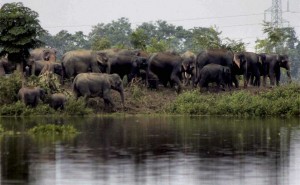 Forest officials of Assam are having many a sleepless nights as they work non-stop to transfer the animals of world renowned sanctuaries like the Kaziranga national park to safer locations. The park known for its population of one horned rhinos was severely affected after flood waters submerged almost all of the forest area.
Forest officials of Assam are having many a sleepless nights as they work non-stop to transfer the animals of world renowned sanctuaries like the Kaziranga national park to safer locations. The park known for its population of one horned rhinos was severely affected after flood waters submerged almost all of the forest area.
The flood season brings many challenges for the North eastern state every year with the River Brahmaputra flowing high above the danger level. While hundreds of people are displaced, the challenge is most for the forest department who need to transfer helpless, stranded animals to safety.
Poaching Threat
Some of the most endangered species of the world reside in this state. The one horned rhino is especially under threat, not just because of the natural calamity but the danger of poachers who find it easy during floods to hunt the animal.
“We have to be on our toes round-the-clock during the flood season as poachers often take advantage of the situation to poach,” said a park official adding that there were no reports this year of any loss of wildlife or major infrastructure damage so far.
“Almost all 153 anti-poaching camps inside the national parks have been operating despite severe floods. Our forest guards are constantly guarding the park not only to prevent poaching but also to help marooned animals,” the official said
Submerged Forests
Till Thursday almost 70 percent of the Kaziranga national park was submerged in water. However, from Friday, the water had begun to recede.
While the Pabitora wildlife sanctuary in Morigaon district is completely submerged, at least 30 percent of the Manas National Park located in Barpeta district has been affected.
As per a census in April 2012 there were 2,290 one-horned rhinos in the KNP, besides thousands of other wildlife species spread over a park area of 860 sq km.
“Mobile patrolling using rubber boats have been intensified in all areas inside the park and all guards have been on duty round-the-clock to secure the lives of wild animals,” said a senior park official.
Apart from the forest rangers, a number of NGOs and local volunteers have been helping the stranded animals.
The forest officials say that the annual floods are an important part of the yearly cycle as they help in washing away of weeds and start a new life cycle in the forest. But this year’s floods has been unprecedented.
While some animals have migrated to the neighbouring Karbi Hills by crossing the national highway 37 (NH 37) that bifurcates the park, some have taken shelter on higher ground inside,” an official said.
This however has brought in another threat to the wild animals. The traffic on the highway and many animals have been hit by speeding vehicles.
“Together with the district administration we are using time-cards along the park portion of NH 37 so as to limit vehicle speeds. Everyone has been asked to drive below 40 kmph while driving through the stretch, and violators have been fined.”
“However it is difficult to monitor all the time and some accidents have taken place causing deaths of a few animals,” said the official.
Distress Call
Sanjib Kumar Bora, Director of Kaziranga National Park says,
“The situation could get worse and we appeal to anyone who comes across distressed wildlife to call on 03776-269563 (Rescue Centre), 03776-262428 (Kohora Range), 03776-268032(Agoratuli), 03672-279012 (Burapahar), 03672-283463 (Bagori) – the emergency help lines immediately. To control road hits, time cards are issued to vehicles by the park authority, which helps check speeding vehicles”
If you wish to volunteer, do contact local organizations like the Wildlife Trust of India or call the Assam Forest Department.
More Related Stories,
Temples in Assam come to the Rescue of Rare Turtles
Rhinos get a Unique Identity Number
Slender Loris on the Hit list of Poachers
Reference Wildlife Trust of India
Image via Firstpost






2 thoughts on “One Horned Rhino and other Wildlife battling Floods in Assam”